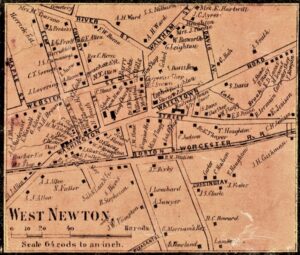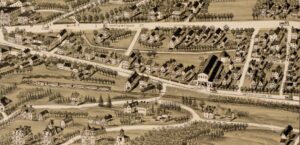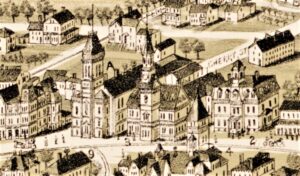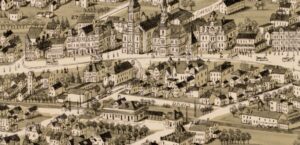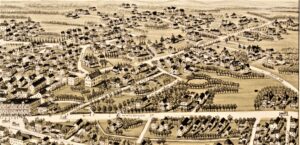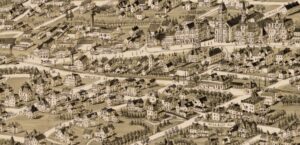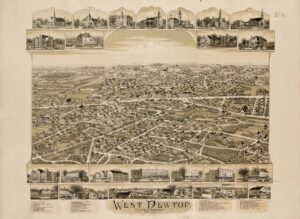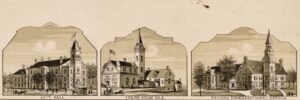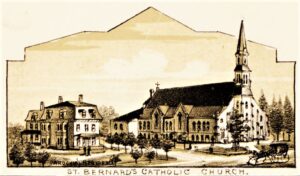West Newton, Mass. in 1856 as I Remember It
By J. Cheever Fuller (1847 – 1935) – Transcribed by W.L. Fuller
| Contents | |
| Introduction | 2 |
| Washington Street – North Side……………………………………………………………………………….. | 3 |
| The Congregational Church and City Hall | 5 |
| The First National Bank Building………………………………………………………………………………… | 5 |
| Washington Street – South Side | 7 |
| Cross Street…………………………………………………………………………………………………………… | 9 |
| Watertown Street – North Side | 9 |
| Watertown Street – South Side…………………………………………………………………………………… | 9 |
| Waltham Street – East Side | 10 |
| Waltham Street – West Side……………………………………………………………………………………… | 10 |
| Cherry Street – East Side | 11 |
| Cherry Street – West Side…………………………………………………………………………………………… | 11 |
| Elm Street – East Side | 12 |
| Elm Street – West Side……………………………………………………………………………………………… | 12 |
| Webster Street – North Side | 12 |
| Webster Street – South Side – Webster Park………………………………………………………………… | 12 |
| Auburn Street – East Side | 13 |
| Chestnut Street – East Side………………………………………………………………………………………… | 13 |
| Chestnut Street – West Side | 14 |
| Highland Street – East Side………………………………………………………………………………………… | 14 |
| Highland Street – West Side | 14 |
| Prospect Street – From Washington to Temple…………………………………………………………… | 15 |
| Fuller Street | 15 |
| Margin Street……………………………………………………………………………………………………….. | 15 |
| Putnam Street | 15 |
| Hillside & Chestnut Avenues. – Austin Street…………………………………………………………… | 16 |
| Otis Street | 16 |
| Temple Street – Then – Pleasant Street…………………………………………………………………… | 16 |
| Greenwood Avenue | 16 |
2. Introduction
West Newton in 1856 was a typical New England country village with the meeting-house, school- house, country stores, its village blacksmith and hand fire engine.
I will endeavor to give a general description of the village as I remember it in 1856: mentioning all the streets, locating the buildings along the lines of these streets, giving the names of the owners or occupants of them as far as possible at that time, and noting the changes as they appear at this time, 1914. When the original house is still standing, I have given the street number as taken from the directory.
It would be quite difficult for any one who was not familiar with the village prior to 1865 to form an idea of how it looked in 1856 as there is hardly an estate that would be recognized at the present time.
Washington Street was then a narrow county road lined on both sides with beautiful shade trees. There were no streets leading north from Washington Street between Lowell Street (now Lowell Avenue) in Newtonville and Waltham Street in West Newton, except Cross Street, which at that tine was only a narrow private way with Cheese-cake brook crossing it on the level. Pedestrians crossed on a plank, when there was one there, and teams had to go through the water. Cheese-cake brook was then a very pretty, quite large and full running stream. Heavy showers caused it to frequently over-flow its banks.
The streets leading north from Washington street were, Waltham, Cherry, Elm, Auburn, Greenough and Woodland. Those leading south from Washington Street were, Chestnut, Highland, Prospect and Fuller. Chestnut, Highland and Washington Street crossed the railroad at grade.
The railroad, then the Boston & Worchester, was on the level with the streets and consisted of two tracks only. It was widened to four tracks about 1882 and in 1894 and 1895 it was depressed (lowered-10 ft), widened and bridged. The grades if Washington, Chestnut, Highland, Putnam and Margin Streets were raised in the vicinity of the railroad, and Austin and Felton were open and carried across the railroad. Putnam Street was extended from Margin across the railroad to Washington Street. The only streets going up the hill were Chestnut, Highland and Prospect. There were only two streets on the hill running east and west: Otis and Temple. Otis ran east from Chestnut towards Newtonville. Temple ran west from Highland to Prospect.
There were no houses on the north side of Otis Street and only three on the south side; all east and south being woods. There was only one house on the north side of Temple Street, which was on the corner of Prospect Street. There were three houses on the south side of Temple Street; all south and west being fields and woods.
Nearly all the land between Highland and Prospect Streets was divided into fields and pastures by familiar New England field stone walls. There was a running brook where the Baptist Church and the houses on the south side of Lincoln Park are now.
The greatest changes in the village, outside of the many new Streets and new building, is notices along the line of Washington Street and the railroad. The depression of the railroad and the widening of Washington Street in 1894 and 1895 caused changes in nearly all the estates along their lines. Nearly all the beautiful shade trees on Washington Street between Newtonville and the railroad crossing at Washington Street in West Newton were destroyed, many of the buildings between Washington Street and the railroad were removed, the grades of the streets in the vicinity of the railroad were raised and all the bridges built.
The streets on the north side of Washington Street and parallel to it were Webster, from Waltham to Webster Park. Beyond that was swamps and a good peat meadow. River Street, from Waltham Street to the Waltham line. Auburndale, was called Emerald Street at that time.
The only people or their descendants, who are now living in the same house that they lived in 1856, are Mr. John P. Eager on Otis Street, Mrs. Monks on Watertown Street, Mrs. John Thompson (formally Miss Emma Bosworth, daughter of William Bosworth on Waltham Street), Miss Allen, daughter of Nathaniel T. Allen on Webster Street, Captain John Ryan, son of Edward Ryan on River Street corner of Auburndale Avenue, Frank Hunter son of Ira Hunter on Putnam Street, Miss Dix daughter of William Dix on Fuller Street and Miss Allen daughter of Augustus Allen on Washington Street near Lower Falls.
It will be almost impossible for me to give in detail all the changes in the village from 1856 to 1914 [first draft], fifty-eight years, but I will try and locate as many of the old buildings as possible, and in doing so, I shall be obliged to mention many of the present buildings. I cannot give the names of all the owners or of the occupants, but will do the best I can. I shall take each street separately. Taking one side at a time and will commence with Washington Street, starting from Newtonville and going west.
3. Washington Street – North Side
Starting on the north side of Washington Street at Lowell Street (now called Lowell Avenue) and going west. There was a house owned by Mr. Brooks, I am unable to tell what became of it. The first house west of the present Brooks Avenue, No. 949, was occupied by Mr. Brigham. It stood there without much alteration until a few years ago when it was altered so that it would never be recognized.
Next was a large mansion house which was on the knoll about midway between the present Brookside Avenue and Eddy Street. Mr. Joseph Walker lived there many years. The house was removed in 1909 and Harrington Street laid out through the land. About midway between the present Eddy and Parsons Streets was a very pretty grove of evergreen trees in which stood the home of Mrs. Coffin and the Mrs. Goodale. When Eddy and Parsons Streets were laid out the grove was destroyed and the house moved to Eddy Street.
Mr. Charles Estes lived in the house now owned by Mr. March on the East corner of Cross Street and Mr. Artemas Cook lived on the West corner of Cross Street. The former is now No. 58 Cross Street and there is very little change in the house. Mr. Cook’s house was turned to face Cross Street a few years ago and changed somewhat. It is now No. 63 Cross Street. The Massachusetts State Armory, which was completed on February 1911, occupies the site of the home of Mr. Charles H. Jennison. The house was moved in 1908 to Wildwood Avenue.
The third house west of the Armory, No. 1171 & 1173 Washington Street, was the home of Elias Jennison and his family for many years. It passed out of their hands a few years ago, and not much has changed in the house. The oldest family house in the village is the brick house (now painted brown), No. 1183-85 on the East corner of the present Dunstan Street. It was originally owned by Nathaniel Fuller senior, but in 1856 it was owned and occupied by Roger Jermain. There is very little change in the house, but considerable change to the grounds caused by the widening of Washington Street and the construction of Dunstan Street. No. 1205-1207 Washington Street. This house has been so much changed that it would not be recognized. It was occupied by Mr. Paine and there was a large barn east of the house which was removed years ago and is now replaced by a garage. No. 1235, the first house east of the livery stables and was occupied for many ears by Seth Davis, who was called Squire Davis before he built a red brick house on the north side of Watertown Street. In 1856 it was occupied by Legrand Lucas. No change in this house as I remember it.
There is nothing notable about the livery stables or the old brick hotel west that I can remember. The stable was operated under the name Thayer & Smith in 1856 and then by Daniel Smith and soon after that by Stephen Cate who was succeeded by his son Stephen F. Cate and then by his son Henry F. Cate. It is now in the hands of Mr. Smart. The hotel was managed by James P. Snow in 1856, but soon after by James H. Cushman. It does not look any different today.
In the square at the junction of Washington and Watertown Streets, were some large elm trees and a town water pump. A brick block known as Robinson’s Block, on the east corner of Waltham Street now occupies the site of the house and stores of Mr. John Mead. Mr. Mead kept a regular country store and I think he kept everything except medicines. H was also the postmaster for many years. When the brick block was erected, the house and stores were moved to the east side of Waltham Street and were altered by the tenements. The building on the west corner of Waltham Street was known for many years as “The Village Hall.” Miss Mary A. Lloyd kept a dry and fancy goods store in the east half and Joseph Silver a Tailor shop in the west half. There was a market underneath kept by Allen & Baker (August Allen and Aaron Baker). The upper part of the building has not changed much, but the lower part has been very much changed. The Newton Police Station, which was formerly the Pierce School House, occupies the site of the house and barn of Dr. Edward Warren. The barn was west of the house and was burned down many years ago. The House was moved to the east side of Cherry Street when the school house was erected.
5. The Congregational Church and City Hall
About the year 1848 the first church of the Second Congregational Church Society was moved west and it was altered into a school house in the upper part and the lower part into the Town Hall. The Land sloped back from the street so that the floor of the Town Hall was very much below the level of the street. This was the only school house for West Newton and Auburndale for many years. Mr. Newcomb was principal and Miss Sarah Fuller was his first assistant. Miss Mc Redding was the teacher of the primary department which was in the upper part of the building. There is nothing about the place that would ever be recognized today. The present church building is so much altered, especially the exterior, that anyone who worshiped there as late as 1865 would not recognize it.
5. The First National Bank Building
This building on the west corner of Cherry Street, occupies the site of the home for many years of Mrs. Bacon, Henry Smith and Mr. Garrett. There was a good grocery store just west of this house and before 1856 Henry Smith kept it and then Brown & Goulding (Harvey Brown and William Goulding) and the last owner was Mr. H.P. Barber. I do not know what happened to the house or the store.
The old tavern is still standing but was altered into three tenements and in 1856, Mr. Ware lived in the east end and George Fuller in the west end. I cannot remember who lived in the middle. There was an old elm tree just west of the tavern and the upper part was removed in 1910, but the trunk of the tree is still standing. The town water pump was a little to the east of the tree and the water was the best in the village. Nearly all the farmers stopped to water their horses at this well.
The grocery store on the east corner of Elm Street was kept by Capron C. Cook in 1856, but soon after it went into the hands of Benjamin F. Houghton who kept it for many years and at his death was continued by Fred L. Cock. The front of the store was set back from the street in line with the large elm tree and had a patio in front with stairs on the outside to the tenement up above. Mr. Houghton’s widow died there in 1910.
The Central Block on the west corner of Elm Street Occupies the site of the home for many years of Mr. William Johnson and this house was moved back on the lot and now faces Elm Street. The next house was occupied in 1856 by Henry Litchfield and later by Dr. F. N. Palmer and for many years later by Dr. Albert Nott. The front of the house has been changed by the ugly looking tower on the east corner. The next building was occupied by Isaac Snow and was in the Snow family until very recently. Isaac kept a drugstore in the east part and Mr. Budd a grocery store in the west end. Isaac succeeded his father and continues the business until a few years ago when there was an estate sale.
From this point west, the change has been so great that there is not a building or spot that could recognize. Next to Snow’s building, there was a long two-family house owned by Nathaniel Fuller which in 1856 was occupied by Amasa Dexter and Mrs. McNamara and at present there is only a small portion of the old house left. Just west of the house on the east corner of Lucas Court, the little paint shop was occupied by Mr. Gideon Dexter and then Charles Phillips. The building is still there but has been much altered. The present brick “The Caroline” occupies the site if the home for many years of Aron Baker who lived in the east half and Mr. Charles Stone in the west half of the house. There was a blacksmith shop that stood where brick block owned by the Eddy Estate is now; it was not in use in 1856.
This brings us to the railroad and across and on the north side stood the Flag Shanty of John Riley. Mr. Riley managed with his one arm to repair shoes between the times he had to flag the trains if he needed them to stop. There was a l0ng one story house just west of the Flag Shanty which was occupied by Mr. Healy and John Quilty and it was removed in 1859 or 1860. The Mt. Zion Church was the home of John Crowley for many years and stood in the back part of the paint shop owned by George Fuller, on the south side of Washington Street and was moved to its present location about 1860.
The house owned by Joseph Commons was at that time occupied by Mr. Jelly. There was another house in the same style as the Commons hour that stood on the site of the current Fire Department building, which was occupied by Mr. Burdett. The Andrew Peters estate was a long one story building occupied by Mr. Wentworth and form some time after by S. R. Urbino and was altered into a two story house by Mr. Peters. The next house stood quite a distance back from the street and the land sloped back from the street and I think it was occupied by Mr. Tucker. This house was brought forward towards the street and the grade of the land raised. Next was the house occupied by Mr. J.H. Wight, who had a carpenter shop in the rear and Mrs. Bacon lived there from some years after.
There was no Catholic Church in West Newton at that time and the nearest was in Waltham. The current Catholic parsonage occupies the site of the large team stable run by Fred Cutter. The land was quite low at the time and contained a few Charcoal kilns. On the west corner of Auburn was the home of Charles Allen and then Jeremiah Allen and in 1913 was moved to the east side of Greenough Street. The large mansion owned by Andrew Jay Allen, the father of Charles and Jeremiah located about 400 feet west of the Charles Allen house, burned down about 1859. The old cellar and a clump of lilac bushed was all that stood until about a year ago. The Ephraim Jackson house which stood on the west corner of Greenough Street was moved away in the early sixties. There were no houses west of this until you the home of Enoch Smith which is still standing with very little change and which was number 1839 and about opposite the Augusta Allen house. The current Woodland golf grounds was the estate of Joseph Jackson who had a large mansion house and large stable in the rear. The house was near the street and had two quite large elm trees in the front and the stump of one of them could be seen a short time ago. This was the home of Rev. Greenough for several years. I burned down in the early sixties.
This is as far west as I shall go on the north side of Washington Street.
7. Washington Street – South Side
Starting at the old blacksmith shop just opposite the present Lowell Avenue which was removed in 1894 when the railroad was depressed and the bridge built just about where the building had stood. A little west was a cottage of Joshua Ramsdell who was the station agent at Newtonville for many years. This house was moved in 1894. Next was the home of Solomon Flagg (or Houghton – on the opposite side of the road) which stood just about at the junction of Felton and Washington Streets. This house was also moved in 1894. The house at 1232-34 has not changed much and was occupied by Dr. E. F. Thaye, father of the late Dr. Fred L. Thayer. A little west of the corner of Chestnut Street was a large house that we knew as the Solomon Flagg estate and some of the Flagg heirs lived in the east part and Miss Mary Lloyd in the west part. This house was removed in 1894/5 during the widening of the street. Dr. Fred M. Low’s house sits on the site of the home of Oscar F. Lucas, which was occupied by Dr. Allston W. Whitney and by Dr. Fred Crockett. The house was moved to the south side of Webster Street between Waltham and Cherry Streets. It is now owned by Miss Allen. The next in line was the cottage of William P. Houghton which is the only building between Chestnut Street and the Washington Street Bridge that is now standing on its original foundation. The surroundings have changes to much that the cottage is not recognizable. Just west of the house Mr. Houghton had a good-sized carpenter shop.
The separation of the street and railroad grades and the extension of Putnam Street through to Washington Street caused the removal of all the buildings west of this point to the railroad crossing at Washington Street. The buildings removed were: George Fuller’s large old-fashioned house, his carriage/harness shops, Charles Cole’s house and barn and blacksmith shop. George Fuller’s house was moved to the south side of Webster Street, just west of Elm Street. The block of the Lewis Gammons estate occupies the site of the home of home of the Triton No. 3 Hand Fire Engine. Deacon Joseph Stone lived on the east corner of Highland Street facing Washington Street and his barn faced Highland Street. The barn was removed and the house moved to the rear of the lot on Highland Street. It is the house jus south of Woodberry’s grocery store. The Fuller Academy, more recently known as the Allen School or the English and Classical School, stood on the west corner of Highland Street and was conducted for many years by Nathaniel T. Allen. Both John Cheever Fuller and his son Frank attended this school. The school building was moved east on Washington Street when the new stone church of the Unitarian Society was built. It is 1244-46 Washington Street and you would never recognize it if you did not know what it was. Just west of the school house was the residence of Joseph Stone the father of Deacon Joseph W. Stone who had a wheel-wright shop just west of the house. The house was moved to the north side of Hunter Street in the early 1860’s and next was a house erected by Colonel Leonard which was moved to 478 Waltham Street when the new Unitarian Church was built. Most of the other buildings were moved, to Elm and Border Streets.
The Fuller House [likely George Fuller] originally stood in about the center of the extension of Putnam Street and the junction of Washington Street. The horse chestnut in the triangle is the only tree standing and was just west of the door in the west end of the house. Jeremiah Allen lived in the east half in 1856 and Rev. Lyman Gilbert lived in the west half. The carriage and harness shops were about 125 feet west of the house, one large and two small buildings. John Cowley lived in a small house that stood in the rear of the shops lot which stood about midway between shops and the house. This house was moved in 1859 to the north side of Washington Street, just west of the railroad and was altered a few years ago and became the Mount Zion Church. He next house was that of Mr. Charles Cole and the next buildings were his barn and blacksmith shops. He lived there until it was moved at the time of the grade separation. The Austin farm house stood just across the railroad about center of the present Lincoln Park. It was occupied by Phil Lamey and Tom Denning and was moved to the west side of Bridge Street in Nonantum in 1859. Next there was a small house just west of the Austin house which was occupied by Bob Bowse and was move about 1860/1. There were no other houses west until you come to the home of Henry Augustus Barker which stands on the original foundation and is now No. 1502 Washington Street.
The Newton Catholic Club House on the west corner of Prospect Street occupies the site of the old Jackson house which was quite a large house and was destroyed by fire in the early 1860’s. George F. Fuller built his house on this site which is not part of the club house. I am not able to give the occupants of the old Jackson house in 1856. The next home was that of James T. Allen which was owned and occupied by John Ayers in 1856. The house and stables were taken down in 1906. Next was the estate of Dr. N. Emmons Paine which was known as the Hastings Estate and was owned by a Mr. Adams and sold to Hastings. This house is now No. 1650 Washington Street. Next comes Fuller Street which now has been merged into Commonwealth Street. The present Atkinson estate on the west corner of Commonwealth Ave. stands on the original foundation and is 1720 Washington Street. J Hubbard Stephenson lived in the house in 1856 and then it was occupied by Mr. Severance. The next house which is now No. 1838 Washington Street, was the home of Augustus Allen and is still occupied by his children, has been much altered. There were no other houses west for this for quite a distance. I will not attempt to give the names of the owners of the three or four houses on this side of Washington Street east of Beacon Street.
9. Cross Street
Watertown Street splits off from left from Washington Street at Waltham Street and was only a private way and the only street leading north from Washington Street between Lowell Street in Newtonville and Waltham Street in West Newton. Cheese-cake Brook crossed the street at grade and [horse] teams had to go through the brook and pedestrians crossed the best they could, usually on a plank. The first house on the east side going north from Washington Street is one now owned by Mr. Marsh, No. 58 Cross Street and before was located on Washington Street and for some years was owned by Charles Estes. Next is No. 40 Cross Street which for many years was the home of K. T. Wiswall but in 1856 was occupied by Francis Walker. Just across the Cheese-cake brook was a building known as the vinegar factory and in 1585 was altered into two houses; No. 12 & 14 Cross Street. One of these houses was occupied by Mr. Clapp, but I cannot remember who lived in the other one. There were no houses on the west side of Cross Street.
9. Watertown Street – North Side
The first house starting from Cheese-cake brook and going west on Watertown Street is No. 761 which is the Monks estate and was in that family prior to 1856. It is still occupied by their descendants of the original family and there has not been much change to the house. Next is No. 819 Watertown Street and was the J. H. Freeland estate but owned now by Mr. Tomlinson. Number 835 was the William Adams estate but is now occupied by William W. Wells. These last two houses have been altered so much that I would not have recognized them. The next house is now No. 893 Watertown Street and was the Adolphus Smith estate which did not have any changes for many years but I would not recognize it today. The next house now occupied by Mr. Furbush on the private driveway known as Davis Avenue was occupied by Mr. Charles Rich in 1856. The house is now No. 66, Davis Avenue and after the Rich family became the home of the late Dr. Fred E. F. Thayer the father of the late Dr. Fred L. Thayer. Seth Davis, always known as Squire Davis, lived in the brick house which stands back from the street and is not No. 32 Eden Avenue. There is no change to the house but the surroundings are very much changed. Squire Davis lived to be 101 years old.
9. Watertown Street – South Side
Starting from Cheese-cake brook and going west. The first house on the west corner or Cross Street belonged to Patrick Keegan and was removed some years ago and three apartment houses now occupy this lot. House No. 868 Watertown Street was originally occupied by Milo Lucas and after by Thomas Drew. House No. 876 was occupied by Mr. Lucas (no relation to Milo). House No. 882 was the home for many years of Philemon Stacy and is still in the family as his son, George E. now lives there. No. 886 was the house of Silas Stone who had a small shop in the rear. The last four houses are on the original foundations but the houses have been altered. Soon after 1856, Milo Lucas built another house on the lot and it is now No. 892 and owned by Mr. Crate. The last house, the Round House, No. 930, was occupied by Mr. Wingate. No other houses on this side of the street.
10. Waltham Street – East Side
The first house on the east side or this street was the little school house which was kept by Miss Harriet Davis, daughter of Squire Davis and it stood on the site of the present-day Davies school house. It was a very pretty building with a belfry and a working bell and stood in a grove of beautiful trees. It was not used as a school in 1856 and soon after was moved to the south side of Webster Street and altered into a house. It was occupied for some years by Mr. Jared Mansfield, altered several times since and is No.152 Webster Street where the current owner is Mr. J. A. Demone. House No.454 looks just the same as it did in 1856 when William Bosworth lived there. It is still in the family as his only daughter, Mrs. Emma Thompson lives in it now.
Mrs. Purdy’s house still stands on the east corner and faces Davis Avenue with the No. 3 Davis Avenue. It is now owned by Mr. Charles Burrill and I do not think there has been any changes to the general appearance of the house. At the time, Davis Avenue was only a private driveway into the Purdy house and the home of Gardner Tufts which is not owned by Joseph A. Symonds. There has been no change to this house either. Continuing along Waltham Street we come to the estate of Mr. Hartwell that stood on the corner of Davis Ave. and is set back but is now No. 432 Waltham Street. For many years this house was occupied by Mr. Charles Field and has not changed over the years. There was a small cottage house owned by Mr. Pike which was moved when No. 420 was built a few years ago. In 1856/7 Andrew B. Potter built a house on the site of their old homestead which is now No. 404 Waltham Street. The old house was moved to the south side of Auburndale Avenue and made into two separate houses, one of which burned and the other is still standing and owned by Catherine E. Ryan and is No. 6 Auburndale Avenue. Mr. Hobart lived in the next house which is now No. 398 and owned by Charles A, Potter. Next was the Avery P. Ellis estate which is now No. 390 and I think is still owned by one of his sons. The general appearance has not changed. The last house on this side of the street at the time, is now No. 280 Waltham Street and was occupied by Mr. Coffin and more recently known as the Hall estate. I think it is now occupied by Mr. Webster.
10. Waltham Street – West Side
David Sanger’s carpenter shop was the first building on this side of the street and stood a little south of Patrick Keegan’s wheelwright shop. The carpenter shop burned many years ago, but Patrick Keegan’s wheelwright and blacksmith shops are still standing with some alterations. This is now No. 515 and owned by James P. Ramee. Just across the brook, where the block of tenements currently stand, was a tinsmith shop owned by Samuel Wells, which was moved some years ago.
The home for some years of the late Dr. Fred L. Thayer on the north corner of River Street, occupies the site of the large old mansion house of Henshaw Ward – No. 473. Next was the Samuel Kilburn estate, No. 425 and there is not much change in this estate. The next old house, gable end towards the street was occupied by Mr. Woodford in 1856 and is now part of the Kilburn estate, No. 399. Albert Day built the large French roof house on the south corner of Derby Street in 1856 and it was known for many years as the Gane estate, No. 331.
The house on the north corner of Derby Street was at the time occupied by Mr. Joseph Newell, No. 309. I think a Mr. Jones, Consul to Mexico, lived there just before George Stephenson. Mr. Robert L. Day lived in the next house and Addison Macullar lived there after Mr. Day. It was more recently known as the Cook estate. Mr. Vernon E. Carpenter’s house was occupied by Mr. James P. Snow. Beyond this estate, on Waltham Road, was the home of Deacon Joel Fuller which was later occupied by John Rent. There were now more houses on this street.
11. Cherry Street – East Side
There were no buildings south of Webster Street. The first house north of Webster Street was the home of Mr. Pierce who was known a Father Pierce. This house is now the home of C.F. Eddy and is very much changed. George Allen, brother of Nathan T. Allen, lived in the second house north of Mr. Pierce and was the last house on this side of the street south of River Street. There was a large factory for manufacturing oil floor covering about where the present Henshaw Street enters Cherry Street. I think the factory was burned in 1859. I am not familiar with the territory north of here, so will not attempt to go over it now.
11. Cherry Street – West Side
There were no buildings south of Webster Street but north of Webster Street there were four cottage houses just about alike, all painted white, also a small building used as a music school by Miss Francene Babcock. The owners of the houses were: Willard Plympton, A.E. Royce, Captain Snow and Capt. Cummings. Mr. Edward Upham moved the first two to Webster Place and erected his large French roof house. The next house is occupied by Dr. C.E.A. Ross and the next by Mr. Charles L. Berry. Just north of the Capt. Cummings estate was the Smith farmhouse which was removed many years ago. Beyond this was Mrs. Pearson on the south corner of River Street. This brings us to the old Cemetery, a good place to rest.
12. Elm Street – East Side
The first building on the east side was the home of Capron C. Cook on the south corner of Webster Street. It is now occupied by Fred L. Cook, a nephew of C.C. There is very little change in this house. Mr. Lovering lived on the north corner of Webster Street, which is now owned by the estate of Marcus Morton. The house has changed considerably. Washington Gilbert lived in the third house beyond the original Lovering house. Mr. Lucius Pratt lived in the next house. Mr. A.E. Royce lived here for many years. Both houses have very much changed. John Perkins lived in the third house beyond Mr. Pratt’s and was the last house on this side of the street.
12. Elm Street – West Side
First were the old express stables. Mr. Ware carried on the business in 1856 and was soon succeeded by Harvey Brown. The buildings were burned in the latter part of 1910. Next was Obed Porter’s paint shop which was altered into a house and for many years was occupied by Mrs. Healy. It is now on the south corner of Border Street. Dr. J.H. Brown lived in the house on the south corner of Webster Street, which is now used as a day nursery. There were no other houses, I think, on this side of the street until you come to the estate of the late Edward P. Bond, which is the last house in the street. I think it was owned by Mr. Savage in 1856.
12. Webster Street – North Side
The home of Nathaniel T. Allen, Principal of the English and Classical School, was the first house on the north side of the street going west from Waltham Street. The estate has the same general appearance with very few changes. Mrs. Allen and daughters are still living there. There were no other houses on this side of the street until you come to the one just west of Oak Avenue and Maple Street no owned by R. Frank Gammons. I think this house was owned by Rodney Lucas at that time. I do not remember any houses west of this.
12. Webster Street – South Side – Webster Park
The first house on the corner of Waltham Street was occupied by Samuel Wells, later by Mr. Fairbanks and now owned by C.A. Potter. I think David Sanger lived in the next house which was later occupied by J.P.A. Hawkes and the last owners were the Frank Humphry estate. Mr. Berry lived in the next house and Mr. Charles Stone in the next. There were no buildings on this side of the street until you come to the cottages just west of Elm Street. There were originally 10 of these cottages, all about the same architecture, built by Mr. Robinson in 1849 and 1850. One burned in 1850 but the rest are still standing on their original foundations. Some have been altered but most retained their original look.
The first cottage was owned an occupied by Dr. L.M. Fitch and the second by Rev. Mr. Knapp now by E.E. Burdon, the third by Joseph N. Bassett now the property of his daughter Mrs. Nickerson, the fourth was the home of the late Ashael Wheeler and is occupied by his daughters, the Misses Wheeler. The fifth house burned in 1850, the sixth was occupied by Gideon Dexter now by R.M. Lindley. This was the last house in the street and was swamps and peat meadow beyond. There were four cottages in the west side of Webster Park, the corner one was occupied by James Thurston, father of the present Miss. Thurston. I am mixed upon the occupancy of these cottages n 1856, so will not attempt to put anyone in them at this time.
13. Auburn Street – East Side
The first house on the east side from Washington Street was that of Obed Porter which was to the rear of the lot some years ago. The house was to the rear of the lot some years ago. Frank Linnell lives in the old home of Luther Bailey and there has been very few changes in general appearance to the house. Mr. Bingham lived in the one story house which was for many years later owned by Nathan Pike, who made a two story house out of it and it not recognizable. I am unable to give the name of the occupant of the next house which is now owned by Mr. Inman. Very few changes in this place. Nathan Crafts lived for many years in the old home opposite Greenough Street. The house is still standing but very much dilapidated and out of repair. Beyond this was the home of Mr. Comer which was a very pretty and neat estate. When Commonwealth Avenue was laid out, this house was turned around and the whole place changed.
13. Chestnut Street – East Side
Chester Judson lived in the first house on the east side, on the corner of Washington Street. There were no other houses on this side until you come to the present Pierce School House on the south corner of Austin Street which was then called Hillside Avenue. The Pierce School House occupies the site of the home of the Rev. Joseph Clark. The house was moved to the rear of the lot when the school house was built. The gothic cottage as short distance beyond was then occupied by Mr. Howard and after by Kendall. The house has been altered but I could recognize it. The next house beyond was the home of Rev, Henry Lambert, which has been moved back from the street and completely changed and now occupied by Jones. Mrs. Lamb[e] lived in the old Bullough house on top of the hill, which has moved to the corner of Valentine Street, when Mr. Travelli built his large stone mansion which afterwards burned. Mr. Prendergast lived in the woods just beyond.
14. Chestnut Street – West Side
The first building was the insurance office of Seth Davis who was called Squire Davis. This street was not laid out then. The coal and wood yard of the village was there at the time and was carried on by John C. Bixby who was the railroad station agent for many years. The first house south of the railroad was occupied by Mr. Hinckley and which has been known as the Garrison estate. The old Howland homestead was next. The house was moved to the rear of the lot and faced onto Highland Street when Mr. Charles Howland erected the present house. Next was the Horace Mann estate and I think it was occupied by Mr. Backus in 1856. Mrs. Quimby kept a boarding house there about that time. This estate has been completely changed so much that I would not have recognized it. There were no other houses on this side of the street.
14. Highland Street – East Side
There were no buildings on the east side between Washington Street and the railroad. The first house south of the railroad was a gothic home of Israel Lombard which is now occupied by Oliver D. Homer. The general appearance of the house has not changed. Galen Merriman’s estate was next just opposite Temple Street and for many years the home of George Frost. There have been quite a number of changes to this house. There were no other buildings on this side of the street.
14. Highland Street – West Side
The only building on the west side between Washington Street and the railroad was the old Fuller Academy. The first house south of the railroad was occupied by Mr. Newcomb, the school teacher, then later by Professor Sheldon. It was the house at the south corner of what is Hunter Street which did not exist then. The next house was owned by J.W. Plympton, who was the father of Mrs. Lucius G. Pratt. There were no other houses north of Temple Street, however the first house south of Temple Street was the home of Sarah Baxter and later owned by Elisha Wood. This house has since been torn down. There were no houses from here until Chestnut Street. The old Robinson house which is now owned by Mrs. Travelli, was built by Charles Robinson in 1859/60. The next house beyond Chestnut Street was the old Buller(?) house. It was located at the site where Mr. Travelli built his large stone house and at that time the Buller house was owned by Mr. Valentine, who moved across Valentine Street to the corner of Highland and Valentine. There was no Valentine Street in 1856 and the house was later owned by George Blaney. The next house was the home of Samuel Parsons at the corner of Leonard Avenue. This house was torn down when Clinton Eddy built his new home in that lot.
15. Prospect Street – From Washington to Temple
There was only one house on the east side and one on the west side of this street. The one on east side was owned by William Flagg Ward and is now owned by Mr. S. Ritchie. It was one of the best places in the village at that time. The one on the west side was known as the Vanduzee estate and I think Addison Macullar lived there in then and if not, he lived there shortly after. It is possible that Mr. Nichols lived there in 1856. He had something to do with building organs.
15. Fuller Street
All the best farms in the village were on this street. On the east side were the farms of Jonathan Day Dix/William Dix and George Frost. The farms on the west side were those of Samuel Dix and Mr. Marble. The descendants of Day and William Dix live in the old homes and George Frost is still living in his old home. The Samuel Dix house on the west side is now occupied by Mr. Howard and the Marble farm is owned by Mr. H.B. Day. The northern end of Fuller Street has been merged into Commonwealth Avenue.
15. Margin Street
North Side – the railroad station was the only building on the north side. The railroad, then at grade, ran along the north side of the street as now.
South Side – Starting from Chestnut Street, the first house was that of Jonathan C. Bixby, the station agent for many years. The house and railroad surroundings have changed so that it would be impossible for anyone to tell just how it looked in 1856. Next was the home of the late Dr. Perkins on the corner of Highland Street which was occupied by Mr. Garrett, the superintendent of the silk factory which was also on Margin Street, a short distance west. There were two houses on the west corner of Highland Street occupied by foreman of the silk factory. One was moved to Curve Street many years ago and the other is still in position, but somewhat changed. The silk factory stood between this house and the Elm tree on the land now owned by Mr. Carpenter. They manufactured silk lace and ribbons but it burned in the early sixties. Two houses now occupy the site of the old factory. There were no other buildings on this street.
15. Putnam Street
There was no Putnam Street in 1856, but there was a narrow lane running up to the home of Nathaniel Fuller which is now the home of Frank Hunter. The house had a pitched roof but was soon altered by Mr. Ira Hunter who purchased it from Nathan Fuller in early 1856. The street was named Putnam Street when it was eventually extended through to Temple Street. No other houses on this street for some time.
16. Hillside & Chestnut Avenues. – Austin Street
North Side – there were no houses on this side, but soon after Chester Judson built two houses; one occupied by Lemuel Caswell and the other by Increase N. Tarbox. The houses are still there but somewhat altered. The was short and only ran in just beyond these houses.
South Side – Rev. Joseph Clark’s house was at the on the corner now occupied by the Pierce School House. The only other house was owned and occupied by Mr. Whiting and which is owned by A.D. Blodgett now. Not much has changed in this house.
16. Otis Street
There were no buildings of any kind on the north side of the street. Mr. J.P. Eager lived in the first of three houses on this street on the west corner of Lenox Street. Mr. Eager still lives there and there has not been many changes to the house. Next is the large house on the east corner of Lenox Street which was the home for many years of Increase S. Wethington. It is now owned by the Lindsay estate. The third house was about six hundred feet east of Mr. Wethington’s house and occupied by Mr. J.S. Campbell. The house has been moved to Somerset Road and now owned by Hartridge. Lenox Street at the time was a narrow lane and I think it was called Spring Street.
16. Temple Street – Then – Pleasant Street
In 1856, Temple Street ran only from Highland and Prospect Streets. There was only one house on the north side of the street and that was on the east corner of Prospect Street. I think the house was first occupied by Rev. Geo. B. Little and then by Hazleton and still later by Braman and then by Mr. Patterson. Mr. Jarvis Lamson moved the house to the south side of Temple Street when he built his present home. There were only three houses on the south side. Going west from Highland Street, the first was a little cottage occupied by the late Wilder M. Bush. In 1856, it was occupied by Mr. Hills, conductor on the Boston & Worcester railroad and has been changed very much. The next was the Babcock’s house, now owned by Richard Buntin and has not changed much. The third house was that of Mr. Loring, located about midway between the Buntin and Bush houses. It was moved some years ago to Curve Street.
16. Greenwood Avenue
This was only a private way leading from Washington Street, just opposite the old home of Charles Jennison across the railroad. This was the only approach to the home of J.H. Cushman (now the Tilton estate), the home of Luther Turner (now owned by Charles Davis) and Mr. Lincoln’s house which was known for some years as the Works estate. The railroad crossing was abolished when the grades were separated in 1894. The houses are now accessible from Austin Street.
I think I have mentioned all the streets in the village of West Newton in 1856, except for Auburndale Avenue, which was Emerald Street at that time. I am not familiar enough with the residence of that street and the northern part of River Street to attempt to locate the houses.
I do not think I have every house exactly located, but I have done the best I could after so many years.
I would esteem it a favor, and thank anyone who might read these notes to send me any corrections or changes.
J. Cheever Fuller
22 Shaw Street
West Newton
Mass. USA
1918
_______________________________________________________________________
Notes:
- Images from this open source Map of West Newton in 1890 have been inserted into the original manuscript as they give a visual impression of the town and buildings that the author is trying to portray. These 1890 images may not exactly line up with the author’s 1856 descriptions and the reader should be aware there may be differences. Reproduction courtesy of the Norman B. Leventhal Map & Education Center at the Boston Public Library.
- Map Legend by number.
- City Hall, Engine House No. 2, and the Congregational Church by Legend number
- Baptist Church, Unitarian Church, and the Public School by Legend number
- The Catholic Church by Legend number.

